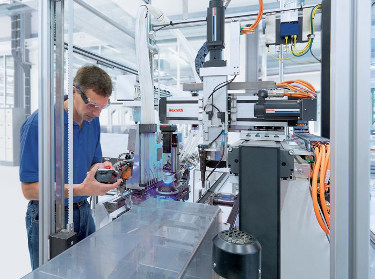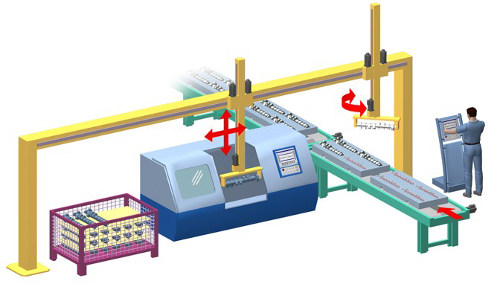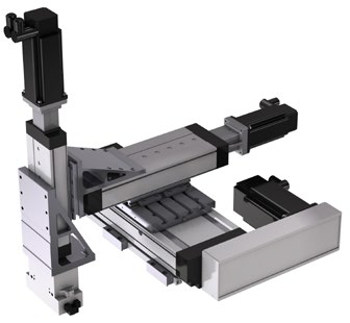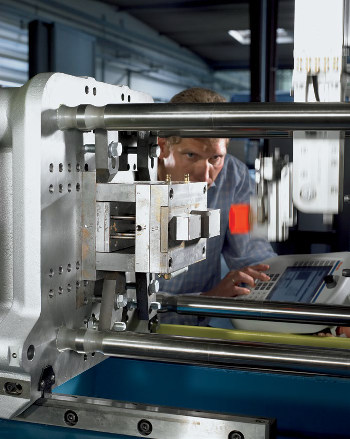 |
| April 15, 2014 | Volume 10 Issue 15 |
Designfax weekly eMagazine
Archives
Partners
Manufacturing Center
Product Spotlight
Modern Applications News
Metalworking Ideas For
Today's Job Shops
Tooling and Production
Strategies for large
metalworking plants
Engineer's Toolbox:
Advances in robotics can empower smaller manufacturers

Cartesian robots offer the same quality, reliability, speed and return on investment benefits as SCARA or articulating robots, with many possibilities for customization.
Once found mostly in manufacturing environments with extremely high volumes, robots are now being used in smaller organizations and in a wider variety of applications. The cost of implementing robotic systems has fallen significantly, plus it is now easier to apply robotics in more ways. The reason is simple: Over the last few years, controls have become more user friendly, requiring fewer programming resources. System design has become easier with the availability of online tools to help end-users and OEMs build systems directly. Servicing has also become easier and faster thanks to standardized components and powerful diagnostics.
These developments have come at a critical time. Small- and medium-size manufacturers in developed economies are facing increasing global competition. Advances in today's robotics are delivering competitive advantages that help them survive and thrive.
More applications, less cost
The use of robotics is justified in more applications because the cost/benefit ratio has become extremely attractive. For all robot system types, implementation costs have fallen dramatically, but especially for mechatronic systems in the form of multi-axis Cartesian robots. Standardization, modularity, and economies of scale have made Cartesian robot systems more affordable for more applications. Those factors, in conjunction with reductions in engineering, have allowed total cost of ownership prices to drop by up to 25 percent over the last five years. Plus, Cartesian robots offer the same quality, reliability, speed, and return on investment benefits as SCARA or articulating robots, with many possibilities for customization.
These benefits are encouraging smaller companies to explore the use of robots in new applications. This is especially true of Cartesian robots, which are already being used in a wide variety of applications such as automated storage and retrieval, pick and place, liquid dispensing, packaging, machine tool auxiliary operations, and many more.
The creativity of Cartesian robot users is boundless. During the recent recession, companies found ways to reinvent themselves, and people who never used Cartesian robots before created new applications. Unlike a six-axis or SCARA robot that can't be repurposed and has an established set of parameters and direction of movement, a Cartesian robot can be easily reconfigured. To accommodate changing production requirements, an overhead-mounted Cartesian robot could be changed to a side mount or flipped in a different direction. This flexibility makes it possible to rebuild machines instead of buying new equipment.

Once found mostly in high-volume manufacturing operations, robots are now being used in smaller organizations and in a wider variety of applications.
Making the best robotics choices at the best price
Because of the many robotics options, end-users sometimes face a dilemma in choosing between entry-level and high-performance features. People have different perceptions of how to define performance, speed, power, or expensive controls.
The best approach is to use a defined set of sizing and selection criteria to determine the required robotics feature set. This makes it possible to create a highly tailored robotic system that performs at exactly the right level and at the best possible price. The evaluation criteria include: Load, Orientation, Speed, Travel, Precision, Environment, and Duty cycle. We call this "LOSTPED."
One common misconception is to think that you need to buy a robot fully equipped with high-performance features. That is inevitably the case with SCARA and six-axis robots, where you tend to see "feature overkill." But with a Cartesian system, building blocks for a basic system can be purchased and then later customized. Mounting brackets, actuators, motors, and controls can be changed as application needs change.

Cartesian system mounting brackets, actuators, motors, and controls can be changed as application needs change.
There are pros and cons to this approach. The compact size of a SCARA robot might be more suitable for work inside a tight envelope. But if you have adequate space, a simpler Cartesian system can often be pre-built without having to purchase all the extra features included in a SCARA or six-axis design.
Moving from an entry-level to a high-performance feature set brings improvements in precision, cycle times, and application capabilities. High-performance controls, for example, provide circular interpolation capabilities. That is a true high-performance capability, requiring sophisticated and expensive control features. However, if the application only requires point-to-point motion (to pick up paper cups for example), that level of accuracy is not needed; a lower-level control can be used on the same robot to save money. High-performance mechanical components in a machine tool may require the accuracy of precision-machined ball rail tables. They will cost more than a less-precise compact linear motion module that's geared toward pick-and-place applications. A case-by-case LOSTPED evaluation will determine the best combination of performance and cost.
Which robot platform makes the most sense?
As a rule of thumb, compared to a Cartesian robot, a SCARA or six-axis system will deliver higher performance out of the box at a higher cost and with greater programming requirements, but with a smaller footprint, less weight, and less rigid arm extension. On the other hand, a Cartesian system provides building blocks to create a solution that costs less and involves fewer engineering resources, while proving more rigidity for better precision and higher payloads.
As an example, a six-axis robot can move in all the planes that a human arm does. For applications where there is a mechanical interference, such as a box in a corner with parts inside, a six-axis arm can bend to reach in and grab that part more easily. This type of robot may cost more than a Cartesian solution, but it works for that application.
It's a different case for a pick-and-place application with a 20-kg payload where high accuracy is not required. Both a SCARA and a Cartesian robot could handle the application. But a 20-kg payload is at the upper end of a SCARA robot's capabilities, requiring more costly controls and components. With a Cartesian robot, a 20-kg payload is no problem, which makes it possible to save money by downsizing the mechanics, using smaller components and less complex controls. In this case, a Cartesian choice is a more cost-efficient solution.
Cartesian robots also make sense when the application involves long spans. In one example, a gantry system was constructed from linear modules for an automated storage and retrieval system. The X-axis was nearly 10 m long. A SCARA or six-axis system cannot handle that travel range.
Heavy loads may also be ideal for Cartesian robots. One application example involves a bearing machining center with parts that weigh about 70 kg. These payloads exceed the capabilities for a typical SCARA or six-axis system, unless it's a "Terminator"-size robot. In this case, however, a Cartesian robot was simply bolted to the end of an existing machine to pick and place these parts, eliminating back strain and other safety issues for workers who were manually handling these heavy parts.
An example of a smaller application involves a high-volume medical pipette manufacturer. In this case, space was tight. The manufacturer was able to use compact Cartesian robot modules to achieve the required precision while meeting its space constraints. The company could also use standardized catalog/off-the-shelf components to fit its frame, in addition to motors from the same source and existing controls from a third party -- saving money for a better return on investment.
Advances driving wider robotics adoption
More small-size companies are implementing Cartesian robotics because of these value-adding advancements:
- Online specification, selection, and CAD tools have dramatically improved, making sizing and specification very simple. Companies like Bosch Rexroth have easy selection tools that can create a linear motion system for single- or multi-axis systems in just a few clicks. All you need to know is the mass that needs to be moved and the required stroke. Of course, this tool does not replace detailed engineering or design calculations, but it simplifies the selection.
- One-part numbering for a complete Cartesian system has simplified ordering. In the past, each element of a Cartesian system was ordered using individual part numbers, sometimes from different vendors. Now the entire system can be ordered with one part number from one vendor -- including rails, servo drives, mechanical elements, and controls -- making the ordering process hassle free.
- Pre-parameterization packages are now available to accommodate the customer's level of controls sophistication. When a customer uses a Bosch Rexroth PLC, for example, Bosch Rexroth can pre-parameterize function blocks for coordinated motion of several axes and load them into the controller at the factory. When end-users get the product, they can program in simplified robotic mnemonic code according to their particular application. The users save time by loading and programming the logic themselves.
- Programming has gotten easier thanks to more consistent programming interfaces and C++ and Java object-oriented languages, along with traditional ladder logic. Because of the IEC-61131-3 standard, the syntax and semantics of programming languages for PLCs have been unified. This gives end-users the flexibility to use PLCs from different manufacturers. Plus, it enables programmers who are familiar with object-oriented languages to become PLC programmers, instead of working in ladder logic or a proprietary PLC language.
- Machine and operator safety is more responsive than ever. Traditionally, implementing a safety circuit on a Cartesian robot meant hooking up to the control. As a result, when the control initiated the signal to the motor's drive amplifier, there was always a slight delay. Now, intelligent servo drives can be equipped with safety capabilities directly at the drive level, enabling a faster response. This circuit also enables Cartesian robots to operate in a reduced torque mode similar to six-axis and SCARA robots in "teach" mode. Operators can enter a safety cage to teach the robot the coordinates for picking and placing manually. If the robot contacts the trainer during this mode, the torque drops off immediately to prevent injury.
- Standardized choices in actuators, linear motors, feed modules, and simple-to-configure modules make it easy for users to specify the exact performance level they need. Instead of traditional ball screw or belt drives, it's now possible to select compact modules that come complete with a linear motor drive unit and controller. Feed modules are also available to provide motion similar to a SCARA robot on the Cartesian robot's Z-axis, where traditionally the entire module body had to move. Standardized mounting brackets offer centering rings that replace traditional dowel pins as a standard feature on the guideway option for modules. This lets end-users build their own "erector set" mechatronics robot from standard components rather than customize the machine for every application, without sacrificing flexibility.
- Modularity in the Cartesian robot family, along with standardized components, has made it easier to implement solutions over a wider performance range at less cost than purpose-built robots.
- After initial programming, it is now easier to train operators to make basic machine changes. Given that function blocks can be pre-loaded into drives, a lower-level worker who is unfamiliar with programming can easily handle programming for simple pick-and-place applications. It's almost as simple as moving a pen from point A to point B on a piece of paper. The simplicity reduces training time for operators and reduces the need for an engineer to make changes to a machine that's running on the floor.
- Machine controllers have become capable of handling third-party robots without the need for a dedicated controller. This development is valuable for any brand of robot. Whether using the latest Sercos III, Ethernet/IP, or EtherCAT interface, today's robots can easily communicate with devices (e.g., in a vision system, in conveyor tracking, and in sensor communication). Being able to communicate using today's latest protocol standards between different devices reduces the cost for a robotics control investment.

Advances in control technology allow operators to safely enter the machine cage to "teach" the robot coordinates for picking and placing.
Empowering end-users now and in the future
As the cost of implementing robotic systems has decreased significantly in recent years, end-users feel empowered to use robotics in applications far beyond high-volume manufacturing environments. Robotics of all types are being applied in many creative ways, with Cartesian robots being especially notable for "breaking out of their box" due to advances in linear servo motors, modules, standardized components, and operator-friendly controls that lower costs and boost performance. Manufacturers are always striving for faster cycle times to increase throughput and avoid bottlenecks. These advances are providing smaller companies with the productivity gains they need to succeed in a world constantly demanding more flexibility and greater productivity.
Learn more about Bosch Rexroth Linear Modules and Cartesian Systems.
Source: Bosch Rexroth Corp.
Published April 2014
Rate this article
View our terms of use and privacy policy
